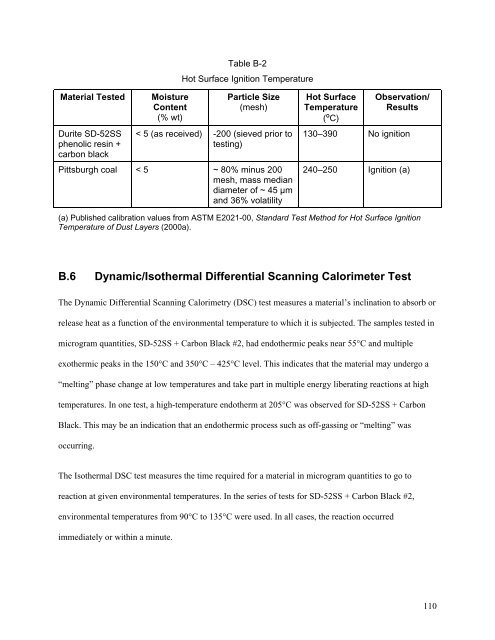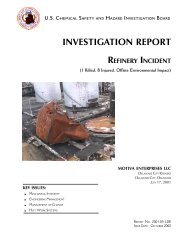CTA Report, Draft 1, ISP Review - US Chemical Safety and Hazard ...
CTA Report, Draft 1, ISP Review - US Chemical Safety and Hazard ...
CTA Report, Draft 1, ISP Review - US Chemical Safety and Hazard ...
Create successful ePaper yourself
Turn your PDF publications into a flip-book with our unique Google optimized e-Paper software.
Material Tested Moisture<br />
Content<br />
(% wt)<br />
Durite SD-52SS<br />
phenolic resin +<br />
carbon black<br />
Table B-2<br />
Hot Surface Ignition Temperature<br />
Particle Size<br />
(mesh)<br />
< 5 (as received) -200 (sieved prior to<br />
testing)<br />
Pittsburgh coal < 5 ~ 80% minus 200<br />
mesh, mass median<br />
diameter of ~ 45 µm<br />
<strong>and</strong> 36% volatility<br />
Hot Surface<br />
Temperature<br />
(ºC)<br />
Observation/<br />
Results<br />
130–390 No ignition<br />
240–250 Ignition (a)<br />
(a) Published calibration values from ASTM E2021-00, St<strong>and</strong>ard Test Method for Hot Surface Ignition<br />
Temperature of Dust Layers (2000a).<br />
B.6 Dynamic/Isothermal Differential Scanning Calorimeter Test<br />
The Dynamic Differential Scanning Calorimetry (DSC) test measures a material’s inclination to absorb or<br />
release heat as a function of the environmental temperature to which it is subjected. The samples tested in<br />
microgram quantities, SD-52SS + Carbon Black #2, had endothermic peaks near 55°C <strong>and</strong> multiple<br />
exothermic peaks in the 150°C <strong>and</strong> 350°C – 425°C level. This indicates that the material may undergo a<br />
“melting” phase change at low temperatures <strong>and</strong> take part in multiple energy liberating reactions at high<br />
temperatures. In one test, a high-temperature endotherm at 205°C was observed for SD-52SS + Carbon<br />
Black. This may be an indication that an endothermic process such as off-gassing or “melting” was<br />
occurring.<br />
The Isothermal DSC test measures the time required for a material in microgram quantities to go to<br />
reaction at given environmental temperatures. In the series of tests for SD-52SS + Carbon Black #2,<br />
environmental temperatures from 90°C to 135°C were used. In all cases, the reaction occurred<br />
immediately or within a minute.<br />
110









